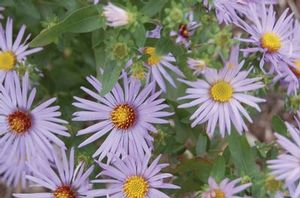New Moon Nurseries

Good for meadows, bird and butterflies, and use as a landscape ornamental. Aromatic aster is drought tolerant.
Aster oblongifolius 'Raydons Favorite'
Aromatic aster
Native to North America (cultivar)
FIRST IMPRESSIONS: Aster oblongifolius ‘Raydon’s Favorite’ is a billowy mounding perennial. A multitude of starry blue-purple daisies appear in early autumn and clothe plants for about two months. Robust plants are tough and adaptable prospering in sun and drought. This cultivar has a darker flower color, more flowers and denser growth than the species.
HABITAT & HARDINESS: Aster oblongifolus is native to dry prairies and rocky slopes in the Central and Eastern United States.
The cultivar ‘Raydon’s Favorite’ is a nursery selection first sold by Allen Bush at Holbrook Farms. Bush received a piece of the plant from Raydon Alexander of San Antonio, Texas. The accompanying note stated that this aster was Raydon's favorite. The plant is believed to have originated near Lookout Mountain, Tennessee.
Plants are hardy from USDA Zones 3-8.
PLANT DESCRIPTION: Aster oblongifolius ‘Raydon’s Favorite’ is densely branched and globe shaped. Plants forms small colonies from underground rhizomes.
Leaves are oblong and up to 4” long. Like most asters, leaves are much smaller and narrower on the upper stems.
Flower heads consist of many deep violet-blue ray flowers surrounding a cluster of yellow disc flowers. Scattered blossoms occur during the summer and then in profusion for a long period in fall. Flowers are large, showy, prolific and attractive to bees, skippers and butterflies.
Plants grow up to 3’ tall with at least a 3’ spread.
CULTURAL & MAINTENANCE NEEDS: Aster oblongifolius ‘Raydon’s Favorite’ grows best in full sun but will tolerate partly shaded areas that have at least a half day of sun. If planted with aggressive taller plants, this aster will decline.
Plants thrive in average to dry conditions and adapt to drought, clay, alkaline and poor rocky soils.
Foliage is somewhat unpalatable to deer and rabbits but occasional nibbling does occur.
LANDSCAPE USES: This is a particularly showy aster that can be used in traditional gardens as a sustainable substitute for fall chrysanthemums. It is a good choice for a Wildlife Garden or Sunny Meadow. Plants are also used as Butterfly Nectar Plants, Butterfly Host Plants, Cut Flowers or as part of a Grouping or Mass Planting. Aster oblongifolius ‘Raydon’s Favorite’ has Showy Blooms and can be used in Cottage Gardens, Deer Resistant Plantings, Water-wise Landscapes, Low Maintenance Plantings or Perennial Borders.
COMPANION & UNDERSTUDY PLANTS: Try pairing Aster oblongifolius ‘Raydon’s Favorite’ with Rudbeckia subtomentosa, Solidago rugosa ‘Fireworks’, Liatris aspera, and Andropogon gerardii.
Aster oblongifolius or Aster oblongifolius ‘October Skies’ can be substituted if needed.
TRIVIA: Many of the established Latin names of Aster spp. were changed recently due to DNA and genetic research findings. So Aster oblongifolius ‘Raydon’s Favorite’ is now known as Symphyotrichum oblongifolium ‘Raydon’s Favorite’.
Plants host caterpillars of the Silvery Checkerspot Butterflies and of several moths.
The Chicago Botanic Garden’s Plant Evaluation Program conducted a comparative study of 119 different asters. Aster olbongifolius ‘Raydon’s Favorite’ was one of 7 asters that received the highest rating. According to the study, “Top rated asters displayed consistently strong habits, superior flower production, excellent disease resistance and full winter hardiness throughout a six-year evaluation term.”
Height:
3 ftSpread:
3 ftSpacing:
3-6 ftUSDA Hardiness Zone:
3-8Bloom Color:
BlueAster oblongifolius 'Raydons Favorite' Characteristics
Attracts Wildlife
- Butterflies
- Pollinators
Attributes
- Rain Garden
- Favorite
- Drought Tolerant
- Dried Flower
- Cut Flower
- Clay Soil
- Long Blooming
Exposure
- Full Sun to Partial Shade
Deer Resistant
- Deer Resistant
Flowering Months
- October
- September
- August
Foliage Color
- Green
Growth Rate
- Fast
Juglans nigra Tolerance (Black Walnut)
- Yes
Salt Tolerance
- Medium
Season of Interest (Foliage)
- Fall
- Summer
- Spring
Soil Moisture Preference
- Moist to Dry
Interesting Notes:
AKA Sympyotrichum o. 'Raydons Favorite'